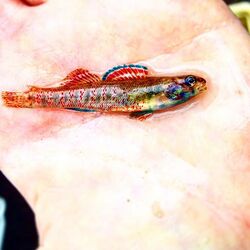Biology:Greenthroat darter
| Greenthroat darter | |
|---|---|

| |
| from the Comal River, Texas | |
| Scientific classification | |
| Domain: | Eukaryota |
| Kingdom: | Animalia |
| Phylum: | Chordata |
| Class: | Actinopterygii |
| Order: | Perciformes |
| Family: | Percidae |
| Genus: | Etheostoma |
| Species: | E. lepidum
|
| Binomial name | |
| Etheostoma lepidum Baird & Girard, 1853
| |
The greenthroat darter (Etheostoma lepidum) is a species of freshwater ray-finned fish, a darter from the subfamily Etheostomatinae, part of the family Percidae, which also contains the perches, ruffes and pikeperches. It is found in Colorado, Guadalupe and Nueces River drainages in Texas ; and in Pecos River system in New Mexico.[2]
Habitat Associations
Macrohabitat: Basically a spring-run species.[3] Mesohabitat: Scarce or absent from very eurythermal locations.[3] Occurs in a variety of non-turbid stream habitats with substrates from bedrock to silt covered (Platania 1980). A typical riffle species occurring over gravel and rubble, especially when aquatic vegetation is present. It also lives in spring areas, sometimes in cool vegetated pools.[4] Largest populations occur in vegetated rocky riffles.[5][6][7][8] Species benthic after hatching.[6][9]
Biology
Spawning season
October or November through May, with populations in stenothermal environments having a longer spawning season than those in more eurythermal environments.[6][3] In the Colorado River, Texas, spawning occurs November – May;[10] in the South Concho River, Texas, spawning occurs October – May.[11] Hubbs (1985)[3] reported marked drop in reproductive activity when water temperature was raised from 20 to 23 °C.
Spawning habitat
Eggs laid on vegetation,[12] or on the underside of rocks.[6]
Fecundity
In the South Concho River, TX, eggs averaged 1.3 mm in diameter, and increased in number with female size; average number of eggs in females examined was 74, with a range of about 15–200.[11] In aquaria, spawning was observed at approximately 15–25 °C; over a 63-day period, a pair of Etheostoma lepidum laid 13 batches of eggs; numbers of eggs laid ranged from 47 to 109, totaling 1,115.[12] Optimal temperature for egg production apparently 20–23 °C; a female held at this temperature range was observed to produce eggs, in the laboratory environment, over a period of at least 251 days.[6] Egg incubation success is low above 24 degrees C.[13] At 28 degrees C, eggs hatch in 4–5 days, and hatch in about 40 days at 9 °C. Hubbs (1985)[3] noted that no difference in egg production could be correlated with daylength.
References
- ↑ NatureServe (2014). "Etheostoma lepidum". IUCN Red List of Threatened Species 2014: e.T202500A2745352. doi:10.2305/IUCN.UK.2014-3.RLTS.T202500A2745352.en. https://www.iucnredlist.org/species/202500/2745352. Retrieved 19 November 2021.
- ↑ "Etheostoma lepidum, Greenthroat darter". http://www.fishbase.org/Summary/speciesSummary.php?ID=3435&AT=greenthroat+darter.
- ↑ 3.0 3.1 3.2 3.3 3.4 Hubbs, C. 1985. Darter reproductive seasons. Copeia 1985(1):56-68.
- ↑ Kuehne, R.A., and R.W. Barbour. 1983. The American Darters. The University Press of Kentucky. Lexington. 177 pp.
- ↑ Strawn, K. 1955. A method of breeding and raising three Texas darters. Part I. Aquarium Journal 26:408-41
- ↑ 6.0 6.1 6.2 6.3 6.4 Hubbs, C., and K. Strawn. 1957. The effects of light and temperature on the fecundity of the greenthroat darter, Etheostoma lepidum. Ecology 38:596-602.
- ↑ Hubbs, C., R.A. Kuehne, and J.C. Ball. 1953. The fishes of the upper Guadalupe River. Texas Journal of Science 5(2):216-244.
- ↑ Hubbs, C., and A.A. Echelle. 1972. Endangered non-game fishes of the upper Rio Grande basin pp. 147–167. In: Rare and endangered wildlife of Southwestern United States. New Mexico Game and Fish Dept., Santa Fe.
- ↑ Paine, M.D. 1984. Ecological and evolutionary consequences of early ontogenies of darter (Etheostomatini). pp. 21–30. In: Lindquist, D.G., and L.M. Page (eds.), Environmental Biology of Darters. Dr W Junk Publishers, The Hague.
- ↑ Developmental temperature tolerance of four etheostomatine fishes occurring in Texas. Copeia 1961:195-198.
- ↑ 11.0 11.1 Hubbs, C., M.M. Stevenson, and A.E. Peden. 1968. Fecundity and egg size in two central Texas darter populations. Southwestern Naturalist 13:301-323
- ↑ 12.0 12.1 Strawn, K. 1956. A method of breeding and raising three Texas darters. Part II. Aquarium Journal 27(1):11-32.
- ↑ Hubbs, C., A.E. Peden, and M.M. Stevenson. 1969. The developmental rate of the greenthroat darter, Etheostoma lepidum. Amer. Midl. Nat. 81:182-188.
Wikidata ☰ Q585450 entry
 |


